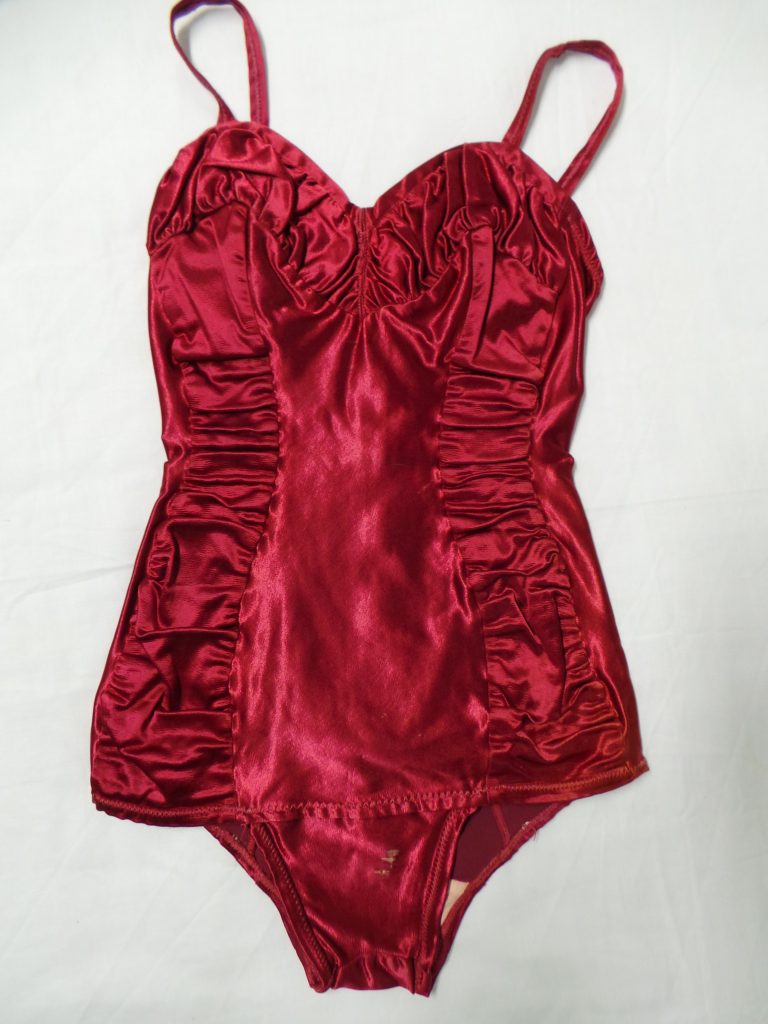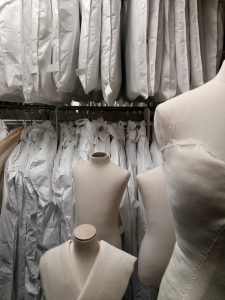
Graduate Iona Farrell describes how passion, persistence and hard work paid off in her quest to find a museum job

Image 1: 1950s sateen and lastex swimsuit by duCros from the Plume collection, Southend Museum (image by author)
I graduated in 2016 from Brighton’s BA (Hons) Fashion and Dress History degree and am now Assistant Curator of Social History at Southend Museum, where I work with the social and local history collection as well as the extensive costume archive. Highlights of the collection include the EKCO radio archive and the Plume swimsuit archive, the largest collection of swimwear in the country.
Brighton provided me with the starting step to pursue a career in museums. What I most enjoyed was how tutors encouraged primary research through visiting archives and using the University’s Dress History Teaching Collection. This approach has proved useful within my current role, where I am often handling artefacts. In a recent donation to the museum I used my undergraduate training to explore a beautiful silk chiffon dress. The garment’s delicate stitching showed the handiwork of a skilled dressmaker, whilst a tiny tear on the fragile hem pointed to a heel catching in the fabric, perhaps when the wearer was dancing. Details like this will inform how the garment is stored, as well as providing a ‘biography’ of an object crucial for creating an exhibition narrative.
Throughout my time at university I loved uncovering stories like these and spent many an hour at St Peter’s House Library using its extensive periodical and microfiche archive. One of my favourite projects was researching the clientele of 1920s couture, which meant poring over the Vogue archive. At times like these I knew I had chosen the right degree! For all current students, I really recommend making the most of these brilliant resources and, being a current Masters student, I must admit I miss the well-stocked shelves of St Peter’s!
In my second year I started research for my dissertation, which explored the performance and liminality of 1950s swimsuit pageants. I was keen to ground my writing in archival research and this led me to Southend Museum’s swimwear archive. Being from Southend, it was fantastic to discover the wealth of the collections and this inspired me to start volunteering. A major project I undertook as a volunteer was cataloguing over 500 swimsuits from the Plume collection. Along the way I assisted in exhibition installations and co-curated an exhibition on the history of toys, allowing me to build up a diverse range of skills. Volunteering seems to be a prerequisite for gaining paid work in Museums and local museums truly can provide brilliant opportunities for anyone intent on working in the sector.
After graduation I worked part-time for the University of Essex Library and started a Masters in Museum Studies, a distance-learning course, which has allowed me to continue to work. I must admit studying for a Masters, whilst being in employment and trying to gain entry into the museum sector was a challenge! As many have probably experienced, gaining work in museums can feel like an uphill struggle of endless online application forms. But I must stress that it will happen eventually! Always take whatever opportunities come your way, whether this means volunteering in your local museum like me, or gaining hands on experience within an archive: it’s all relevant experience and it’s fun.
By volunteering at Southend I was able to build up a large amount of experience and apply for the post of Assistant Curator. It’s fantastic to work now with such a wide-ranging collection and every day is different, whether this be accessioning donations, undertaking exhibition research, taking part in school visits or co-ordinating a touring exhibition. A major responsibility is undertaking the rationalisation of the social history collection, ensuring it is relevant and usable for generations to come. An upcoming project, Snapping the Stiletto will see museums across Essex collaborate to celebrate Essex women and dismantle the ‘Essex Girl’ stereotype. I am excited to build strong partnerships across Essex and the culminating touring exhibition and events across the county are something that people should look out for in the coming year.
It’s fantastic to be in an industry that is so creative, one that has the ability to tell so many stories and to inspire so many people. I am so glad that I applied to Brighton and grateful for the starting step it gave me.

